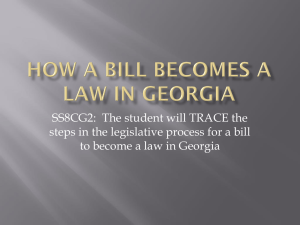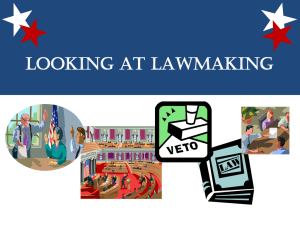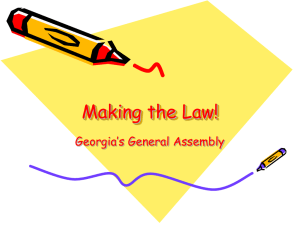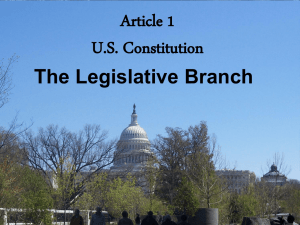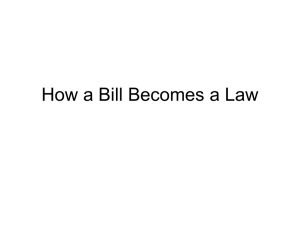Looking at Lawmaking
advertisement
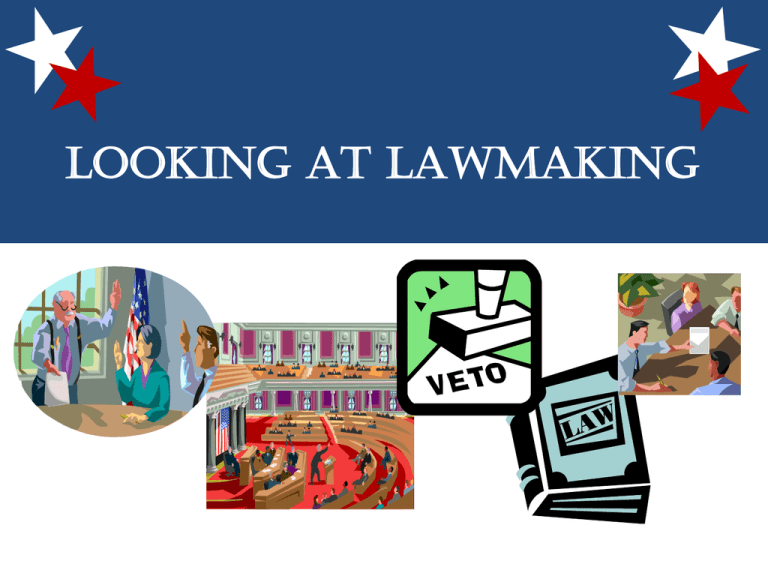
LOOKING AT LAWMAKING Click the pic for the Federalism Facts of Congress! Levels of Government In our federal system of government, the government shares powers between three levels: Government Federal State Local Branches of Government Each level of government is then divided into three branches of government. The legislative, executive, and judicial branches all have different powers, responsibilities, and requirements. Executive Branch Judicial Branch Legislative Branch Federal State Local What does the legislative branch do? Who serves in the Legislative Branch? Congressmen/Congresswomen U.S. Representative U.S. Senator Florida Legislator Florida Representative Florida Senator Commissioner Councilman/Councilwoman Legislative Branch Makes the law What does the executive branch do? Who serves in the executive branch? President Vice President Cabinet Members Governor Lieutenant Governor Cabinet Members Mayor Executive Branch Enforces the law What does the judicial branch do? Who serves in the judicial branch? Justices of the United States Supreme Court Appellate Judges Trial Judges Justices of the Florida Supreme Court Appellate Judges Trial Judges On your worksheet, you will need to correctly identify each branch of government, the role of the branch, and the titles/offices of government officials for each level of government. For the judicial branch, you will need to identify the levels/types of courts. Who Does What? Who Does What? Branch of Government Legislative Executive Judicial Role of this branch Make law Enforce law Interpret and apply the law Federal • Congressman/ Congresswoman • U.S. Senator • President • Vice President • U.S. Supreme Court • U.S. Circuit Courts of Appeal • U.S. District Courts • Florida Senator • Florida Representative • Governor • Lieutenant Governor • Florida Supreme Court • District Courts of Appeal • Councilman/ Councilwoman • County/City Commissioner • Mayor • Circuit Court • County Court • State Local U.S. Representative LOOKING AT LAWMAKING How are laws made in the legislature? Conversation Starter: • Individually write 2-3 sentences for each question. In your group, discuss and compare your responses. – What did Locke say would happen if there was no government or social contract? – What would our country be like without laws? The Hierarchy of Law United States Constitution If there is a conflict between a lower law and a higher one, the higher one “prevails”. Acts of Congress Florida Constitution State Statutes (laws) City and County Ordinances The U.S. Constitution is the “Supreme Law of the Land.” Where does it come from? • Where does Congress get the power to make acts? • Where does the Florida legislature get the power to make laws (statutes) for the state? • Where does the local government get the power to make ordinances? Click the pic to see a Fact of Congress on how a bill becomes a law! The Bill Begins • Laws begin as ideas from individual citizens, groups, or Representatives . • What kinds of ideas important to Florida would a congressman/congresswoman bring up during session? – – – – – – – Immigration National security issues Healthcare Human trafficking Tax laws Minimum wage NASA funding The Bill is Proposed • When a Representative has written a bill, the bill needs a sponsor. • Once a bill has a sponsor and the support of some of the U.S. Representatives, it is ready to be introduced. The Bill is Introduced • In the U.S. House of Representatives, a bill is introduced when it is placed in the hopper—a special box on the side of the clerk’s desk. • The bill clerk assigns it a number that begins with H.R. • A reading clerk then reads the bill to all the Representatives, and the Speaker of the House sends the bill to one of the House standing committees. What is a committee? Committees • Groups of Representatives or Senators who are experts on topics such as agriculture, education, or international relations Some Congressional Committees: • • • • • • • • • Agriculture, Nutrition, and Forestry Appropriations Armed Services Banking, Housing, and Urban Affairs Budget Commerce, Science, and Transportation Education and the workforce Energy and Natural Resources Environment and Public Works • • • • • • • • • Ethics Finance Foreign Relations Health, Education, Labor, and Pensions Homeland Security and Governmental Affairs Judiciary Rules and Administration Small Business and Entrepreneurship Veterans' Affairs The Bill Goes to Committee • When the bill reaches committee, the committee members review, research, and revise the bill before voting on whether or not to send the bill back to the House floor. The bill may be sent to a subcommittee if more information is needed. Here, the bill is closely examined and expert opinions are gathered before it is sent back to the committee for approval. The Bill is Reported • When the committee has approved a bill, it is sent—or reported—to the House floor. Once reported, a bill is ready to be debated by the U.S. House of Representatives. The Bill is Debated • When a bill is debated, Representatives discuss the bill and explain why they agree or disagree with it. • Then, a reading clerk reads the bill section by section and the Representatives recommend changes. When all changes have been made, the bill is ready to be voted on. The Bill Is Voted On There are three methods for voting on a bill in the U.S. House of Representatives: 1. Viva Voce (voice vote): The Speaker of the House asks the Representatives who support the bill to say “aye” and those that oppose it say “no.” 2. Division: The Speaker of the House asks those Representatives who support the bill to stand up and be counted, and then those who oppose the bill to stand up and be counted. 3. Recorded: Representatives record their vote using the electronic voting system. Representatives can vote yes, no, or present (if they don’t want to vote on the bill). If a majority of the Representatives say or select yes, the bill passes in the U.S. House of Representatives. The bill is then certified by the Clerk of the House and delivered to the U.S. Senate. The Bill is Referred to the Senate • When a bill reaches the U.S. Senate, it goes through many of the same steps it went through in the U.S. House of Representatives. The bill is discussed in a Senate committee and then reported to the Senate floor to be voted on. • Senators vote by voice. Those who support the bill say “yea,” and those who oppose it say “nay.” If a majority of the Senators say “yea,” the bill passes in the U.S. Senate and is ready to go to the President. The Bill Is Sent to the President When a bill reaches the President, he has three choices. The President can: 1. Sign it—the bill becomes a law. 2. Veto (refuse to approve) it —the bill is sent back to Congress. 3. Do nothing —if Congress is in session, the bill automatically becomes law after 10 days. If Congress is not in session, the bill does not become a law. Is a veto the end of a bill? • Not quite… – If the U.S. House of Representatives and the U.S. Senate still believe the bill should become a law, they can hold another vote on the bill. – If two-thirds of the Representatives and Senators support the bill, the President’s veto is overridden and the bill becomes a law. Using Handout B and the index cards provided, you will be creating puzzle study cards on how a bill becomes a law on the federal level. On the side with lines, summarize the steps in the process. On the opposite side, illustrate the step of the process. Put It In a Puzzle Idea and Drafting Bill Proposed Bill Introduced Idea from citizen, group or Representative is drafted into a bill. The bill needs a sponsor and support. Once this happens, it is ready to be introduced. A bill is introduced when it is placed in the hopper. It is assigned a number and the bill is read to all Representatives. . Bill is Debated Bill is Reported Committee Representatives discuss the bill and explain their stance on it. The clerk then reads the bill , accepts edits, and then finalizes the changes. Once approved by a committee, the bill is sent, or reported, to the House floor. Committee members review, research and revise the bill and then vote on whether it should be sent to the House floor. May be sent to a subcommittee if more information is needed. Vote on Bill Bill Referred to the Senate Sent to the President LAW The bill is then voted on. A majority is needed for the bill to pass the House. If it passes, it is certified by the Clerk and delivered to the Senate. The bill goes through the same processes as in the House. It is reviewed in committee and reported to the Senate floor where it is voted on. If the President vetoes the bill, the Legislature may override his/her veto by a 2/3 vote. If the President does not veto the bill, the bill becomes law. HOW DOES A BILL BECOME A LAW IN FLORIDA? Let’s look at the process… IDEA DECISION BILL DRAFTED 1ST READING From citizen, group or legislator The legislator decides if the idea should be a bill. Bill written by staff and assigned a number.. Published in Chamber Journal. 3RD READING 2ND READING Same process as original Chamber. Final reading of the bill. The bill is voted on and may die if it does not receive a favorable vote. Bill is read on floor of Chamber and may be placed on Special Order Calendar by vote. COMMITTEE ASSIGNMENT /MEETING Return to Original Chamber GOVERNOR CONSIDERATION GOVERNOR FINAL ACTIONS Final versions of the bill must be identical in both Chambers. Governor can sign the bill into law, allow the bill to become law without signing, or veto the bill. If the Governor vetoes the bill, the Legislature may override his/her veto by a 2/3 vote. . Consideration by Opposite Chamber Bill is reviewed, voted on, and can be placed on calendar or allowed to die in committee. LAW If the Governor does not veto the bill, the bill becomes law. In summary, this is how a law is made: IDEA From citizen, group or legislator . GOVERNOR CONSIDERATION Governor can sign the bill into law, allow the bill to become law without signing, or veto the bill. BILL DRAFTED Bill written by staff and assigned a number. COMMITTEE ASSIGNMENT /MEETING Consideration by Opposite Chamber Bill is reviewed, voted on, and can be placed on calendar or allowed to die in committee. Same process as original Chamber. GOVERNOR FINAL ACTIONS If the Governor vetoes the bill, the Legislature may override his/her veto by a 2/3 vote. LAW If the Governor does not veto the bill, the bill becomes law. Check For Understanding What are some important words to look for in this question? Which answers can we eliminate?
